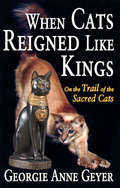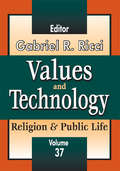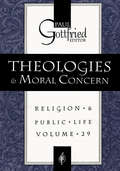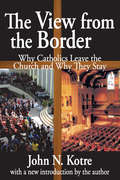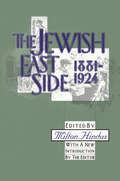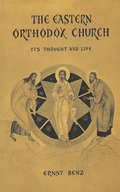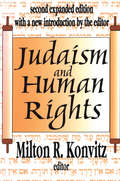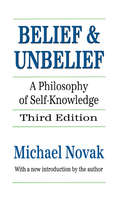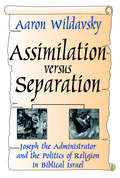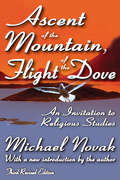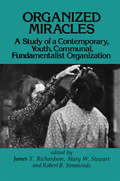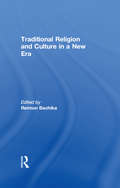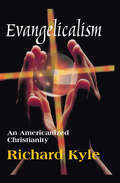- Table View
- List View
When Cats Reigned Like Kings: On the Trail of the Sacred Cats
by Georgie Anne GeyerIn her fascinating exploration of feline history, Georgie Anne Geyer explores the connections between the royal and sacred felines of ancient civilizations and the beloved domestic cats of today. Chasing an irresistible mystery across the globe, Geyer conducts exhaustive research into the little-known puzzle of how cats came to occupy their unique position in the lives of humans. Treated with the tenacity, resourcefulness, and narrative instinct of a seasoned foreign correspondent, the investigation yields unexpected answers and poses tantalizing new questions.It was Geyer's curiosity about her own cats that inspired her to study the history of human-feline relations and especially the exalted status of cats among the ancients as royal or sacred beings. In Egypt, Geyer learned of the cat-goddess Bastet and of the cat's role in the transmigration of souls. In Myanmar she saw Leonardo DiCaprio, Ricky Martin, and the other incongruously named cats of the Nga Phe Kyaung monastery, trained by the monks to jump through hoops. She even met a family who dutifully guards the heritage of the Japanese Bobtail, cultivating the line in of all places rural Virginia.Richly illustrated with photographs of Geyer's journeys and historical cat images, When Cats Reigned Like Kings describes forty-one recognized modern cat breeds plus other popular cats. Every cat lover can, thus, trace his or her cat to these breeds and their many relatives. The result is a remarkable book, bound to delight and amaze cat fanciers and adventure seekers.
Values and Technology: Religion and Public Life (Religion And Public Life Ser.)
by James BurkIn 1749 Jean-Jacques Rousseau's Discourse on the Arts and Sciences, surprised leading Enlightenment thinkers who had enthusiastically upheld the positive benefits of humanity's technological advance. Voltaire, who celebrated the ends of civilization, mocked Rousseau's praise for an original creative state of nature in which man enjoyed an optimum level of freedom.Given the unprecedented intrusion of technology into our lives, the question raised by Rousseau's critique may be even more pertinent. In this volume of Religion and Public Life contributors address some of the challenges to conventional morality brought on by the technological augmentation of the social structure. John Barker's essay explores how Luciano Floridi's philosophy of technology has complicated the conventional way of determining what ought to receive moral consideration. Fani Zlatarova provides a practical guide for incorporating ethical components into teaching computer technology.Grant Havers explores the controversies surrounding the biogenetic explosion through an examination of the competing philosophical perspectives and Christopher Vassilopolos examines the science-based justification for taking life. Gabriel R. Ricci looks at recent political history in the United States in order to highlight the sometimes uneasy relationship between science and social policy. Volume 37 is a welcome addition to the acclaimed Religion and Public Life series.
Values and Technology: Religion and Public Life
by James BurkIn 1749 Jean-Jacques Rousseau's Discourse on the Arts and Sciences, surprised leading Enlightenment thinkers who had enthusiastically upheld the positive benefits of humanity's technological advance. Voltaire, who celebrated the ends of civilization, mocked Rousseau's praise for an original creative state of nature in which man enjoyed an optimum level of freedom.Given the unprecedented intrusion of technology into our lives, the question raised by Rousseau's critique may be even more pertinent. In this volume of Religion and Public Life contributors address some of the challenges to conventional morality brought on by the technological augmentation of the social structure. John Barker's essay explores how Luciano Floridi's philosophy of technology has complicated the conventional way of determining what ought to receive moral consideration. Fani Zlatarova provides a practical guide for incorporating ethical components into teaching computer technology.Grant Havers explores the controversies surrounding the biogenetic explosion through an examination of the competing philosophical perspectives and Christopher Vassilopolos examines the science-based justification for taking life. Gabriel R. Ricci looks at recent political history in the United States in order to highlight the sometimes uneasy relationship between science and social policy. Volume 37 is a welcome addition to the acclaimed Religion and Public Life series.
Theologies and Moral Concern
by Paul GottfriedThis is the twenty-ninth volume in This World, a series on religion and public affairs. It focuses on theological and moral questions of deep significance for our time. The lines of division separating secular and religious outlooks, modernity and postmodernism, and romantic and classical styles of thought are some of the topics treated in this volume. Additional features are an exchange of opinions and a position paper intended to generate further discussion. This ongoing series of volumes seeks to provide a wide-ranging forum for differing views on religious and ethical considerations.Theologies and Moral Concern include the following major contributions: "Distinctions of Power: How Church and State Divide America" by Brian Mitchell; "Beyond the Impasses: Making Moral Sense of Abortion" by Anthony Matteo; "Are Religions Ever Traditional" by Jacob Neusner; "Philosophical Issues in Darwinian Theory" by Kenneth T. Gallagher; "Monotheism and Skepticism" by Aryeh Botwinick; "Defining Romantic Theology" by Gerhard Spiegler; and "The YMCA and Suburban America" by Clifford Putney. In addition, the volume features a dialogue between Michael A. Weinstein and Paul Gottfried on what constitutes the proper role for liberal arts education in contemporary American society as well as a position paper titled "The Pitfalls of Political Correctness" by Lawrence Nannery.Theologies and Moral Concern is part of an annual survey of religion and public life which aims to provide relevant information and ideas about significant issues of the day. It is directly pertinent to understanding the connection between religion and the state. This particular volume, coming at a time of intense public scrutiny of fundamentalism, evangelicism, and new religious movements generally, should have special appeal for political scientists, American studies specialists, sociologists, and those involved in the creation of public policy.
Theologies and Moral Concern
by Paul GottfriedThis is the twenty-ninth volume in This World, a series on religion and public affairs. It focuses on theological and moral questions of deep significance for our time. The lines of division separating secular and religious outlooks, modernity and postmodernism, and romantic and classical styles of thought are some of the topics treated in this volume. Additional features are an exchange of opinions and a position paper intended to generate further discussion. This ongoing series of volumes seeks to provide a wide-ranging forum for differing views on religious and ethical considerations.Theologies and Moral Concern include the following major contributions: "Distinctions of Power: How Church and State Divide America" by Brian Mitchell; "Beyond the Impasses: Making Moral Sense of Abortion" by Anthony Matteo; "Are Religions Ever Traditional" by Jacob Neusner; "Philosophical Issues in Darwinian Theory" by Kenneth T. Gallagher; "Monotheism and Skepticism" by Aryeh Botwinick; "Defining Romantic Theology" by Gerhard Spiegler; and "The YMCA and Suburban America" by Clifford Putney. In addition, the volume features a dialogue between Michael A. Weinstein and Paul Gottfried on what constitutes the proper role for liberal arts education in contemporary American society as well as a position paper titled "The Pitfalls of Political Correctness" by Lawrence Nannery.Theologies and Moral Concern is part of an annual survey of religion and public life which aims to provide relevant information and ideas about significant issues of the day. It is directly pertinent to understanding the connection between religion and the state. This particular volume, coming at a time of intense public scrutiny of fundamentalism, evangelicism, and new religious movements generally, should have special appeal for political scientists, American studies specialists, sociologists, and those involved in the creation of public policy.
The View from the Border: Why Catholics Leave the Church and Why They Stay
by John KotreIn this unique psychological study, John Kotre provides some startling answers to the questions Catholics are now asking about those who abandon the church, those who remain in it, and those who attempt to create a new church within the church. A detailed examination of the borderline between membership and ex-membership in the Catholic Church, as perceived by young adults reared within the Catholic educational system, the book provides an impressive substantive contribution to understanding not only of the modern church, but of organizational change in general.Kotre, himself a product of the Catholic educational system, positions himself amid the tension and ambiguity between those who consider themselves "in" and those who consider themselves "out" of the Catholic Church. He designed a systematic questionnaire covering four hundred variables about each subject's beliefs, values, perceptions of parents, and reasons for being an insider or an outsider. Using this questionnaire he individually interviewed one hundred graduates of Catholic colleges. The surprising results of this important research show that, in spite of sixteen years of formal Catholic education, the attitudes of both the "ins" and the "outs" are not influenced by their Catholic upbringing so much as by their primary group relationships.Recent research has shown that adult Americans are leaving their childhood faiths at ever increasing rates and that the Catholic Church is suffering the greatest losses. Kotre's book offers an insightful psychological perspective on this dramatic movement. It is a must-read for professional psychologists and sociologists, theologians, and people interested in the psychology and sociology of religion.
The View from the Border: Why Catholics Leave the Church and Why They Stay
by John KotreIn this unique psychological study, John Kotre provides some startling answers to the questions Catholics are now asking about those who abandon the church, those who remain in it, and those who attempt to create a new church within the church. A detailed examination of the borderline between membership and ex-membership in the Catholic Church, as perceived by young adults reared within the Catholic educational system, the book provides an impressive substantive contribution to understanding not only of the modern church, but of organizational change in general.Kotre, himself a product of the Catholic educational system, positions himself amid the tension and ambiguity between those who consider themselves "in" and those who consider themselves "out" of the Catholic Church. He designed a systematic questionnaire covering four hundred variables about each subject's beliefs, values, perceptions of parents, and reasons for being an insider or an outsider. Using this questionnaire he individually interviewed one hundred graduates of Catholic colleges. The surprising results of this important research show that, in spite of sixteen years of formal Catholic education, the attitudes of both the "ins" and the "outs" are not influenced by their Catholic upbringing so much as by their primary group relationships.Recent research has shown that adult Americans are leaving their childhood faiths at ever increasing rates and that the Catholic Church is suffering the greatest losses. Kotre's book offers an insightful psychological perspective on this dramatic movement. It is a must-read for professional psychologists and sociologists, theologians, and people interested in the psychology and sociology of religion.
The Jewish East Side: 1881-1924 (The Library of Conservative Thought)
by Milton HindusThis book, originally published as The Old East Side, is a collection of literature and documents ranging from the autobiography of the sculptor Jacob Epstein and the novels of Abraham Cahan to the reporting of William Dean Howells and the fictional reconstruction of a vanished world by Henry Roth. The world is that of the old shtetl transplanted to a new, growing country, where "the ghetto" (in the years 1881-1924) was an unstable mixture of nostalgic elements and the pressures of American economic and social reality.The productivity, both intellectual and material, of the section of New York known as the East Side during those forty years around the turn of the twentieth century has become a legend among many Jews in this country and deserves to become better known to many more of other ethnic origins. The lower East Side was paradoxically a wilderness to be traversed and a portion of that "promised land" which had been glimpsed with so much hope from afar. To wonderfully talented and observant children, like Jacob Epstein, the streets there in the 1880s were as filled with excitement as those of the Arabian Nights. To serious philosophic young men like Morris Raphael Cohen, they were as challenging as the marketplace of Athens had once been to Socrates to achieve intellectual enlightenment and the improvement of the social order.The conditions of abominable crowding and poverty described in the sociological tracts of Jacob Riis, Lillian Wald, and others are better known perhaps to the average reader than the accounts of such pleasures as the dancing schools, the Yiddish theaters, the cafes, the lectures, the literary ferment and activities, described in the pages of Abraham Cahan and Hutchins Hapgood. But all the views presented in The Jewish East Side, both dark and bright, are recognizably parts of the same picture. This book will be of value to sociologists, historians, researchers specializing in Judaic studies, and students of literature.
The Jewish East Side: 1881-1924 (The Library of Conservative Thought)
by Milton HindusThis book, originally published as The Old East Side, is a collection of literature and documents ranging from the autobiography of the sculptor Jacob Epstein and the novels of Abraham Cahan to the reporting of William Dean Howells and the fictional reconstruction of a vanished world by Henry Roth. The world is that of the old shtetl transplanted to a new, growing country, where "the ghetto" (in the years 1881-1924) was an unstable mixture of nostalgic elements and the pressures of American economic and social reality.The productivity, both intellectual and material, of the section of New York known as the East Side during those forty years around the turn of the twentieth century has become a legend among many Jews in this country and deserves to become better known to many more of other ethnic origins. The lower East Side was paradoxically a wilderness to be traversed and a portion of that "promised land" which had been glimpsed with so much hope from afar. To wonderfully talented and observant children, like Jacob Epstein, the streets there in the 1880s were as filled with excitement as those of the Arabian Nights. To serious philosophic young men like Morris Raphael Cohen, they were as challenging as the marketplace of Athens had once been to Socrates to achieve intellectual enlightenment and the improvement of the social order.The conditions of abominable crowding and poverty described in the sociological tracts of Jacob Riis, Lillian Wald, and others are better known perhaps to the average reader than the accounts of such pleasures as the dancing schools, the Yiddish theaters, the cafes, the lectures, the literary ferment and activities, described in the pages of Abraham Cahan and Hutchins Hapgood. But all the views presented in The Jewish East Side, both dark and bright, are recognizably parts of the same picture. This book will be of value to sociologists, historians, researchers specializing in Judaic studies, and students of literature.
The Eastern Orthodox Church: Its Thought and Life
by Ernst BenzWestern European Christendom finds it difficult to comprehend the Eastern Orthodox Church because it knows little about the practice and doctrines of Orthodoxy. Even what is known is overlaid by many strata of prejudices and misunderstandings, partly political in nature. One of the obstacles has been the natural tendency to confound the ideas and customs of the Orthodox Church with familiar parallels in Roman Catholicism. To escape this tradition pitfall, Ernst Benz focuses on icon painting as a logical place to begin his examination of the Orthodox Church.Beginning with a brilliant discussion of the importance of icons in the Eastern Church--and the far-reaching effects of icons on doctrine as well as art--Benz counteracts the confusion, explaining simply and clearly the liturgy and sacraments, dogma, constitution and law of Eastern Orthodoxy. In brief history, he describes the rise of Orthodox national churches, schismatic churches, and churches in exile; the role of monasticism and its striking differences from Roman Catholic monasticism; the missionary work of the Orthodox Church; and the influence of Orthodoxy on politics and culture.The role of the church can be defined in terms of the image. Benz writes that the church exists so that "members may be incorporated into the image of Jesus Christ a in that individual believers are aechanged into his likeness'" as Paul writes in the second letter to the Corinthians. Thus, Orthodox theology holds up the icon as the true key to the understanding of Orthodox dogma. The Eastern Orthodox Church will be valuable to anyone interested in learning more about the church, its thought, its life, and its ideals.
The Eastern Orthodox Church: Its Thought and Life
by Ernst BenzWestern European Christendom finds it difficult to comprehend the Eastern Orthodox Church because it knows little about the practice and doctrines of Orthodoxy. Even what is known is overlaid by many strata of prejudices and misunderstandings, partly political in nature. One of the obstacles has been the natural tendency to confound the ideas and customs of the Orthodox Church with familiar parallels in Roman Catholicism. To escape this tradition pitfall, Ernst Benz focuses on icon painting as a logical place to begin his examination of the Orthodox Church.Beginning with a brilliant discussion of the importance of icons in the Eastern Church--and the far-reaching effects of icons on doctrine as well as art--Benz counteracts the confusion, explaining simply and clearly the liturgy and sacraments, dogma, constitution and law of Eastern Orthodoxy. In brief history, he describes the rise of Orthodox national churches, schismatic churches, and churches in exile; the role of monasticism and its striking differences from Roman Catholic monasticism; the missionary work of the Orthodox Church; and the influence of Orthodoxy on politics and culture.The role of the church can be defined in terms of the image. Benz writes that the church exists so that "members may be incorporated into the image of Jesus Christ a in that individual believers are aechanged into his likeness'" as Paul writes in the second letter to the Corinthians. Thus, Orthodox theology holds up the icon as the true key to the understanding of Orthodox dogma. The Eastern Orthodox Church will be valuable to anyone interested in learning more about the church, its thought, its life, and its ideals.
Judaism and Human Rights
by Carlos RipollAreligion or a culture like Judaism, at least three thousand years old, cannot be expected to be all of one piece, homogeneous, self-contained, consistent, a neatly constructed system of ideas. If Judaism were that, it would have died centuries ago and would be a subject of interest only to the historian and archaeologist. Judaism has been a living force precisely because it is a teeming, thundering, and clamoring phenomenon, full of contrary tendencies and inconsistencies. Although there are no words or phrases in Hebrew Scriptures for "human rights," "conscience," or "due process of law," the ideals and values which these concepts represent were inherent in the earliest Jewish texts.This volume begins with four essays on the concept of man's being born "free and equal," in the image of God. The underpinning of this concept in Jewish law is explored in Section 2, entitled "The Rule of Law." Section 3, "The Democratic Ideal," traces the foundations of democracy in the Jewish teachings in the Bible and the Talmud, which in turn influenced the whole body of Western political thought. Relations between man and man, man and woman, employer and employee, slave and master are all spelled out. Section 4 presents essays analyzing man's freedom of conscience, and his God-given rights to dissent and protest. Section 5 deals with aspects of personal liberty, including the right of privacy. Section 6, entitled "The Earth is the Lord's," deals with the Jewish view of man's transient tenancy on God's earth, his obligations not to destroy anything that lives or grows, and to share the earth's bounty with the poor, the widowed, and the orphaned. Section 7 delivers an analysis of the "end of days" vision of Micah and man's continuing need to strive for peace and not for war. The volume concludes with three new essays, dealing with contemporary issues: "In God's Image: The Religious Imperative of Equality under Law"; "The Values of a Jewish and Democratic State: The Task of Reaching a Synthesis"; and "Religious Freedom and Religious Coercion in the State of Israel."This enlarged edition is accessibly written for a general and scholarly audience and will be of particular interest to political scientists, historians, and constitutional scholars.
Judaism and Human Rights
by Carlos RipollAreligion or a culture like Judaism, at least three thousand years old, cannot be expected to be all of one piece, homogeneous, self-contained, consistent, a neatly constructed system of ideas. If Judaism were that, it would have died centuries ago and would be a subject of interest only to the historian and archaeologist. Judaism has been a living force precisely because it is a teeming, thundering, and clamoring phenomenon, full of contrary tendencies and inconsistencies. Although there are no words or phrases in Hebrew Scriptures for "human rights," "conscience," or "due process of law," the ideals and values which these concepts represent were inherent in the earliest Jewish texts.This volume begins with four essays on the concept of man's being born "free and equal," in the image of God. The underpinning of this concept in Jewish law is explored in Section 2, entitled "The Rule of Law." Section 3, "The Democratic Ideal," traces the foundations of democracy in the Jewish teachings in the Bible and the Talmud, which in turn influenced the whole body of Western political thought. Relations between man and man, man and woman, employer and employee, slave and master are all spelled out. Section 4 presents essays analyzing man's freedom of conscience, and his God-given rights to dissent and protest. Section 5 deals with aspects of personal liberty, including the right of privacy. Section 6, entitled "The Earth is the Lord's," deals with the Jewish view of man's transient tenancy on God's earth, his obligations not to destroy anything that lives or grows, and to share the earth's bounty with the poor, the widowed, and the orphaned. Section 7 delivers an analysis of the "end of days" vision of Micah and man's continuing need to strive for peace and not for war. The volume concludes with three new essays, dealing with contemporary issues: "In God's Image: The Religious Imperative of Equality under Law"; "The Values of a Jewish and Democratic State: The Task of Reaching a Synthesis"; and "Religious Freedom and Religious Coercion in the State of Israel."This enlarged edition is accessibly written for a general and scholarly audience and will be of particular interest to political scientists, historians, and constitutional scholars.
Belief and Unbelief: A Philosophy of Self-knowledge
by Michael NovakThis is perhaps the most widely read of Michael Novak's books. Belief and Unbelief attempts to push intelligence and articulation as far as possible into the stuff of what so many philosophers set aside as subjectivity. It is an impassioned critique of the idea of an unbridgeable gap between the emotive and the cognitive � and in its own way, represents a major thrust at positivist analysis.Written in a context of personal tragedy as well as intellectual search, the book is grounded in the belief that human experience is enclosed within a person to person relationship with the source of all things � sometimes in darkness, other tunes in aridity, but always in deep encounter with community and courage. It is written with a deep fidelity to classical Catholic thought as well as a sense of the writings of sociology, anthropology, and political theory�from Harold Lasswell to Friedrich von Hayek.This third edition includes Novak's brilliant 1961 article "God in the Colleges" from Harper's � a critique of the technification of university life that rules issues of love, death, and personal destiny out of bounds, and hence leaves aside the mysteries of contingency and risk, in favor of the certainties of research, production, and consumption. For such a "lost generation" Belief and Unbelief will remain of tremendous interest and impact.When the book first appeared thirty years ago, it was praised by naturalists and religious thinkers alike. Sidney Hook called it "a remarkable book, written with verve and distinction." James Collins termed it "a lively and valuable essay from which a reflective, religiously concerned reader can draw immense profit." And The Washington Post reviewer claimed that "Novak has written a rich, relentlessly honest introduction to the problem of belief. It is a deeply personal book, rigorous in argument and open ended in conclusions."
Belief and Unbelief: A Philosophy of Self-knowledge
by Michael NovakThis is perhaps the most widely read of Michael Novak's books. Belief and Unbelief attempts to push intelligence and articulation as far as possible into the stuff of what so many philosophers set aside as subjectivity. It is an impassioned critique of the idea of an unbridgeable gap between the emotive and the cognitive � and in its own way, represents a major thrust at positivist analysis.Written in a context of personal tragedy as well as intellectual search, the book is grounded in the belief that human experience is enclosed within a person to person relationship with the source of all things � sometimes in darkness, other tunes in aridity, but always in deep encounter with community and courage. It is written with a deep fidelity to classical Catholic thought as well as a sense of the writings of sociology, anthropology, and political theory�from Harold Lasswell to Friedrich von Hayek.This third edition includes Novak's brilliant 1961 article "God in the Colleges" from Harper's � a critique of the technification of university life that rules issues of love, death, and personal destiny out of bounds, and hence leaves aside the mysteries of contingency and risk, in favor of the certainties of research, production, and consumption. For such a "lost generation" Belief and Unbelief will remain of tremendous interest and impact.When the book first appeared thirty years ago, it was praised by naturalists and religious thinkers alike. Sidney Hook called it "a remarkable book, written with verve and distinction." James Collins termed it "a lively and valuable essay from which a reflective, religiously concerned reader can draw immense profit." And The Washington Post reviewer claimed that "Novak has written a rich, relentlessly honest introduction to the problem of belief. It is a deeply personal book, rigorous in argument and open ended in conclusions."
Assimilation Versus Separation: Joseph the Administrator and the Politics of Religion in Biblical Israel
by Aaron WíldavskyHow to behave in the diaspora has been a central problem for Jews over the ages. They have debated whether to assimilate by adopting local customs or whether to remain a God-centered people loyal to their temporal rulers but maintaining the peculiar customs that separated them from their host nations. The question not only of survival, but of the basis for survival, is also a central problem in the Joseph stories of the Book of Genesis. The work shows its readers the grand alternatives of Judaism, instilled in two larger-than-life figures, so its readers can reassess for themselves the road Judaism did not take, and understand why Joseph though admirable in many respects, is left out of the rest of the Bible. The question is answered through the stories about how Joseph, the son of Jacob, saved his people/family from famine by becoming a high-ranking administrator to Pharaoh. By analyzing his behavior to the people over whom he exercises power, Joseph lords it over his brothers, grieves his father, takes lands from Egyptian farmers, and engages in forced deportation. Wildavsky explains why Joseph-the-assimilator is replaced in the Book of Exodus by Moses-the-lawgiver. The book ends by demonstrating that Joseph and Moses are, and are undoubtedly meant to be exact opposites. As in his earlier book on The Nursing Father: Moses as a Political Leader, Wildavsky combines analysis of political and administrative leadership with both traditional and modern study of texts: thematic linkages via plot, grammar, dreams, poetry, and religious doctrine. Thus the chapter on "Joseph the Administrator" is preceded by a chapter on Joseph as The Dream Lord" and followed by an analysis and explanation of why Jacob's obscure blessings to his sons are more like curses. Always the emphasis is on the reciprocal influence of religion and politics, on rival answers to questions about how Hebrews should relate to each other and to outsiders. New, in paperback, the book will be of interest to biblical scholars and readers as well as those concerned with the interaction of religion and political life.
Assimilation Versus Separation: Joseph the Administrator and the Politics of Religion in Biblical Israel
by Gertrud LenzerHow to behave in the diaspora has been a central problem for Jews over the ages. They have debated whether to assimilate by adopting local customs or whether to remain a God-centered people loyal to their temporal rulers but maintaining the peculiar customs that separated them from their host nations. The question not only of survival, but of the basis for survival, is also a central problem in the Joseph stories of the Book of Genesis. The work shows its readers the grand alternatives of Judaism, instilled in two larger-than-life figures, so its readers can reassess for themselves the road Judaism did not take, and understand why Joseph though admirable in many respects, is left out of the rest of the Bible. The question is answered through the stories about how Joseph, the son of Jacob, saved his people/family from famine by becoming a high-ranking administrator to Pharaoh. By analyzing his behavior to the people over whom he exercises power, Joseph lords it over his brothers, grieves his father, takes lands from Egyptian farmers, and engages in forced deportation. Wildavsky explains why Joseph-the-assimilator is replaced in the Book of Exodus by Moses-the-lawgiver. The book ends by demonstrating that Joseph and Moses are, and are undoubtedly meant to be exact opposites. As in his earlier book on The Nursing Father: Moses as a Political Leader, Wildavsky combines analysis of political and administrative leadership with both traditional and modern study of texts: thematic linkages via plot, grammar, dreams, poetry, and religious doctrine. Thus the chapter on "Joseph the Administrator" is preceded by a chapter on Joseph as The Dream Lord" and followed by an analysis and explanation of why Jacob's obscure blessings to his sons are more like curses. Always the emphasis is on the reciprocal influence of religion and politics, on rival answers to questions about how Hebrews should relate to each other and to outsiders. New, in paperback, the book will be of interest to biblical scholars and readers as well as those concerned with the interaction of religion and political life.
Ascent of the Mountain, Flight of the Dove: An Invitation to Religious Studies
by J. Bowyer BellThe essence of Ascent of the Mountain, Flight of the Dove remains intact: its vision of religious studies as sustained refl ection on our lifelong voyage to discover who we are. The story we choose for ourselves, the story we live, can sacralize or secularize our lives and our world by the way in which we choose to relate to it. With this awareness of the story dimension of life, Ascent of the Mountain, Flight of the Dove opens us to awe, reverence, and wonder at the risks and possibilities of human freedom.This book is even more important than it was thirty years ago. We need religion to strike deeply into the self, away from public glare. Unless Americans become more sophisticated about the language of the self, inner life will shrivel. In addition, our people will continue to be vulnerable to fundamentalist movements. Such movements take over too many innocents. Th ey promise, and sometimes deliver, a touching happiness. But they do so by closing the spirit in a powerful and dangerous way.Families and schools do not provide a large and critical vocabulary by which to express the inner longings of the spirit. The souls of many are parched and they gladly accept water, any water, from those who off er it. Th e liberation of the religious spirit from trivial, closed, and simplistic systems of thought can only be achieved through the development of a critical language, exercises, and disciplines that open rather than close the mind, that lead to higher viewpoints, breakthroughs, and new syntheses, in a constant enlargement of spirit. Novak's book leads us to that place.
Ascent of the Mountain, Flight of the Dove: An Invitation to Religious Studies
by J. Bowyer BellThe essence of Ascent of the Mountain, Flight of the Dove remains intact: its vision of religious studies as sustained refl ection on our lifelong voyage to discover who we are. The story we choose for ourselves, the story we live, can sacralize or secularize our lives and our world by the way in which we choose to relate to it. With this awareness of the story dimension of life, Ascent of the Mountain, Flight of the Dove opens us to awe, reverence, and wonder at the risks and possibilities of human freedom.This book is even more important than it was thirty years ago. We need religion to strike deeply into the self, away from public glare. Unless Americans become more sophisticated about the language of the self, inner life will shrivel. In addition, our people will continue to be vulnerable to fundamentalist movements. Such movements take over too many innocents. Th ey promise, and sometimes deliver, a touching happiness. But they do so by closing the spirit in a powerful and dangerous way.Families and schools do not provide a large and critical vocabulary by which to express the inner longings of the spirit. The souls of many are parched and they gladly accept water, any water, from those who off er it. Th e liberation of the religious spirit from trivial, closed, and simplistic systems of thought can only be achieved through the development of a critical language, exercises, and disciplines that open rather than close the mind, that lead to higher viewpoints, breakthroughs, and new syntheses, in a constant enlargement of spirit. Novak's book leads us to that place.
Organized Miracles: Study of a Contemporary Youth Communal Fundamentalist Organization
by James T. Richardson"Excellent study which moves back and forth between theory and empirical observations. It looks at religious groups from several different theoretical positions as well as raises a number of significant issues about the conduct of eld research."--Russell R. Dynes, American Sociological Association
Organized Miracles: Study of a Contemporary Youth Communal Fundamentalist Organization
by James T. Richardson"Excellent study which moves back and forth between theory and empirical observations. It looks at religious groups from several different theoretical positions as well as raises a number of significant issues about the conduct of eld research."--Russell R. Dynes, American Sociological Association
Traditional Religion and Culture in a New Era
by Reimon BachikaWhere will postmodern culture lead us in the twenty-first century? Will it destroy traditional cultures together with the old, established religions that were its foundation? These questions and the new concerns they evoke are explored in this important collection of original essays. Contributors challenge entrenched assumptions about what many social scientists consider irreversible cultural trends. These include cultural differentiation, emphasis on individual identity, movement toward religion as a private act rather than a community commitment, and above all, emphasis on the relativity of all knowledge and values.The volume asserts three lines of argument in opposition to these trends. The first is the teleological significance of traditional religions and archaic knowledge. History can be said to have no goal, but the same must not follow for human culture. One can conceive individually of a hundred goals to live for. However, the quality of life cannot be that diverse. Taken to the extreme, cultural particularity and philosophical nihilism are insults to the life that emerged on our planet eons ago. Second, this volume emphasizes moral concern and the importance of universal values. Ideas of human well being have been formulated from ancient times. Religious beliefs invariably contain statements of value in the form of commandments and exhortations that express fundamental goals for a quality of life. Third, the nature of religion and spirituality is discussed. Religion today has become controversial socially, and marginal sociologically. The role of religion in society is sometimes problematic or abused, but it is also underestimated and misunderstood. The authors suggest that contemporary religion might best be viewed as non-ideological spiritual culture. This, in turn, looks to a future in which religion and culture coalesce.This volume includes an international cast of scholars from Japan, the United States, Canada, the United Kingdom, Germany, Greece, Italy, New Zealand, and Belgium. All have engaged in research outside their own countries. Taken as a whole, this volume addresses issues of interest to those in the fields of futures studies, religion, and philosophy, and in particular those concerned with human agency, personal responsibility, and public choice.
Traditional Religion and Culture in a New Era
by Reimon BachikaWhere will postmodern culture lead us in the twenty-first century? Will it destroy traditional cultures together with the old, established religions that were its foundation? These questions and the new concerns they evoke are explored in this important collection of original essays. Contributors challenge entrenched assumptions about what many social scientists consider irreversible cultural trends. These include cultural differentiation, emphasis on individual identity, movement toward religion as a private act rather than a community commitment, and above all, emphasis on the relativity of all knowledge and values.The volume asserts three lines of argument in opposition to these trends. The first is the teleological significance of traditional religions and archaic knowledge. History can be said to have no goal, but the same must not follow for human culture. One can conceive individually of a hundred goals to live for. However, the quality of life cannot be that diverse. Taken to the extreme, cultural particularity and philosophical nihilism are insults to the life that emerged on our planet eons ago. Second, this volume emphasizes moral concern and the importance of universal values. Ideas of human well being have been formulated from ancient times. Religious beliefs invariably contain statements of value in the form of commandments and exhortations that express fundamental goals for a quality of life. Third, the nature of religion and spirituality is discussed. Religion today has become controversial socially, and marginal sociologically. The role of religion in society is sometimes problematic or abused, but it is also underestimated and misunderstood. The authors suggest that contemporary religion might best be viewed as non-ideological spiritual culture. This, in turn, looks to a future in which religion and culture coalesce.This volume includes an international cast of scholars from Japan, the United States, Canada, the United Kingdom, Germany, Greece, Italy, New Zealand, and Belgium. All have engaged in research outside their own countries. Taken as a whole, this volume addresses issues of interest to those in the fields of futures studies, religion, and philosophy, and in particular those concerned with human agency, personal responsibility, and public choice.
Evangelicalism: An Americanized Christianity
by Richard KyleMost forms of religion are best understood in the con- text of their relationship with the surrounding culture. This may be particularly true in the United States. Certainly immigrant Catholicism became Americanized; mainstream Protestantism accommodated itself to the modern world; and Reform Judaism is at home in American society. In Evangelicalism, Richard Kyle explores paradoxical adjustments and transformations in the relationship between conservative Protestant Evangelicalism and contemporary American culture.Evangelicals have resisted many aspects of the modern world, but Kyle focuses on what he considers their romance with popular culture. Kyle sees this as an Americanized Christianity rather than a Christian America, but the two are so intertwined that it is difficult to discern the difference between them. Instead, in what has become a vicious self-serving cycle, Evangelicals have baptized and sanctified secular culture in order to be considered culturally relevant, thus increasing their numbers and success within abundantly populous and populist-driven American society. In doing so, Evangelicalism has become a middle-class movement, one that dominates America's culture, and unabashedly populist.Many Evangelicals view America as God's chosen nation, thus sanctifying American culture, consumerism, and middle-class values. Kyle believes Evangelicals have served themselves well in consciously and deliberately adjusting their faith to popular culture. Yet he also thinks Evangelicals may have compromised themselves and their future in the process, so heavily borrowing from the popular culture that in many respects the Evangelical subculture has become secularism with a light gilding of Christianity. If so, he asks, can Evangelicalism survive its own popularity and reaffirm its religious origins, or will it assimilate and be absorbed into what was once known as the Great American Melting Pot of religions and cultures? Will the Gospel of the American dream ultimately engulf and destroy the Gospel of Evangelical success in America?This thoughtful and thought-provoking volume will interest anyone concerned with the modern-day success of the Evangelical movement in America and the aspirations and fate of its faithful.
Evangelicalism: An Americanized Christianity
by Richard KyleMost forms of religion are best understood in the con- text of their relationship with the surrounding culture. This may be particularly true in the United States. Certainly immigrant Catholicism became Americanized; mainstream Protestantism accommodated itself to the modern world; and Reform Judaism is at home in American society. In Evangelicalism, Richard Kyle explores paradoxical adjustments and transformations in the relationship between conservative Protestant Evangelicalism and contemporary American culture.Evangelicals have resisted many aspects of the modern world, but Kyle focuses on what he considers their romance with popular culture. Kyle sees this as an Americanized Christianity rather than a Christian America, but the two are so intertwined that it is difficult to discern the difference between them. Instead, in what has become a vicious self-serving cycle, Evangelicals have baptized and sanctified secular culture in order to be considered culturally relevant, thus increasing their numbers and success within abundantly populous and populist-driven American society. In doing so, Evangelicalism has become a middle-class movement, one that dominates America's culture, and unabashedly populist.Many Evangelicals view America as God's chosen nation, thus sanctifying American culture, consumerism, and middle-class values. Kyle believes Evangelicals have served themselves well in consciously and deliberately adjusting their faith to popular culture. Yet he also thinks Evangelicals may have compromised themselves and their future in the process, so heavily borrowing from the popular culture that in many respects the Evangelical subculture has become secularism with a light gilding of Christianity. If so, he asks, can Evangelicalism survive its own popularity and reaffirm its religious origins, or will it assimilate and be absorbed into what was once known as the Great American Melting Pot of religions and cultures? Will the Gospel of the American dream ultimately engulf and destroy the Gospel of Evangelical success in America?This thoughtful and thought-provoking volume will interest anyone concerned with the modern-day success of the Evangelical movement in America and the aspirations and fate of its faithful.
